Phototermy
SOLAR PHOTOVOLTAIC HOT WATER SYSTEM
What is Photothermy? It involves heating water with photovoltaic panels, using a FOT-T regulator connected to a conventional electric water heater or an inertia accumulator or a heat pump, with a conventional electric resistance, operating with direct voltage from the PV panel (Vdc) to the water heater without a battery or inverter.
| PHOTOTHERMAL ENERGY: MORE ADVANTAGES OVER A THERMAL SOLAR SYSTEM | |
| WITHOUT BATTERY | Does not require a battery. It heats water directly in the water heater without a battery or inverter. |
| VERY SIMPLE INSTALLATION | Only the photovoltaic output cables are needed, and it is connected to the FOT/T VDC protection panel, associated with the electric water heater and temperature control thermostat. |
| CTE-HE4 REGULATION | Complies with the Technical Building Code (CTE) Base Document HE4, meeting the minimum requirements for the generation of Domestic Hot Water (DHW) or for heating. |
| NO MAINTENANCE | Does not require maintenance as it does not include hydraulics (overpressure, freezing risks, solar pump, leaks). |
| TEMPERATURES UP TO 95ºC | Temperatures of up to 95ºC or higher can be achieved daily, with no external energy costs (only photovoltaic and solar radiation). |
WHAT IS PHOTOTHERMAL ENERGY?
Photothermal Energy involves heating water using conventional photovoltaic panels, with an MPPT FOT-T regulator connected to a conventional electric water heater, using a conventional electric resistance (230V), and operating with direct voltage from the PV panel (Vcc) to the water heater, without a battery or inverter.
WHAT IS NEEDED?
a) Photovoltaic panels (410-550W), in a separate off-grid line with a maximum power of 1800-2800W (depending on the FOT-T regulator used) and a line voltage of Vmp 170-230Vdc.
b) The FOT-T regulator 2000 or 3000. The regulator adjusts the power value of the PV panels, operating in PWM-MPPT mode, and acts as a thermostat.
c) A water accumulator or electric water heater or inertia accumulator with an electric resistance. It is important that the accumulator has a connector for the temperature sensor. The resistance can be any model or brand, and it must be 230Vac or three-phase 230/400Vac (3 phases of 230V).
WHAT SAVINGS DOES IT PRODUCE?
For Domestic Hot Water (DHW): With a 200-300L accumulator at 80ºC, suitable for 3-5 people, conventional energy savings are 95-100%.
For heating (as heating support): Using radiators or underfloor heating, savings can range from 35-85% of conventional energy not used.
For large hot water consumers (e.g., hotels, public pools): Gas expenses can be reduced significantly, from €523/day to €38/day (real case).
HOW IS PHOTOTHERMAL ENERGY INSTALLED?
a) Install a photovoltaic panel array on the roof, terrace, or ground.
b) DC protection panel (includes DC fuses/circuit breaker + DC transient overvoltage protectors).
c) FOT-T regulator.
d) Hot water accumulator or electric water heater.
e) Electric resistance for water heating: Any model or brand, as long as it is rated for 230Vac nominal voltage.
NOTE: It is essential to perform calculations to correctly select the power of the resistance based on the available photovoltaic panels or vice versa.
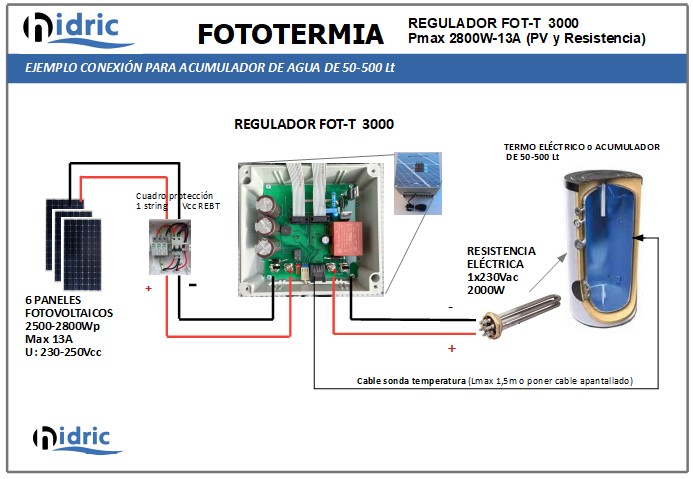
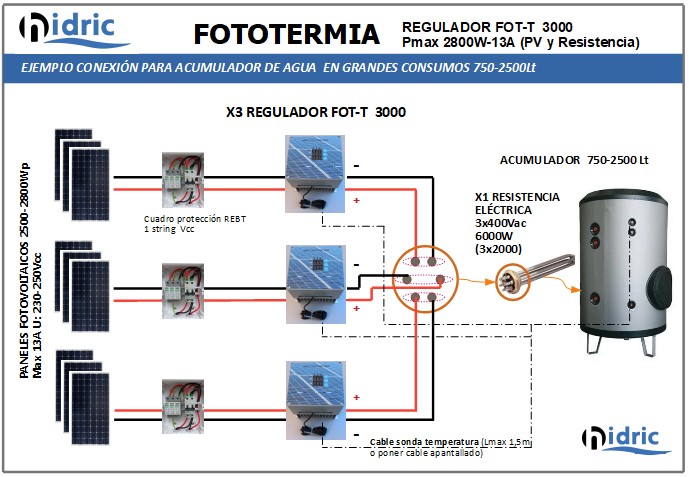
OUR PHOTOTHERMAL REGULATORS
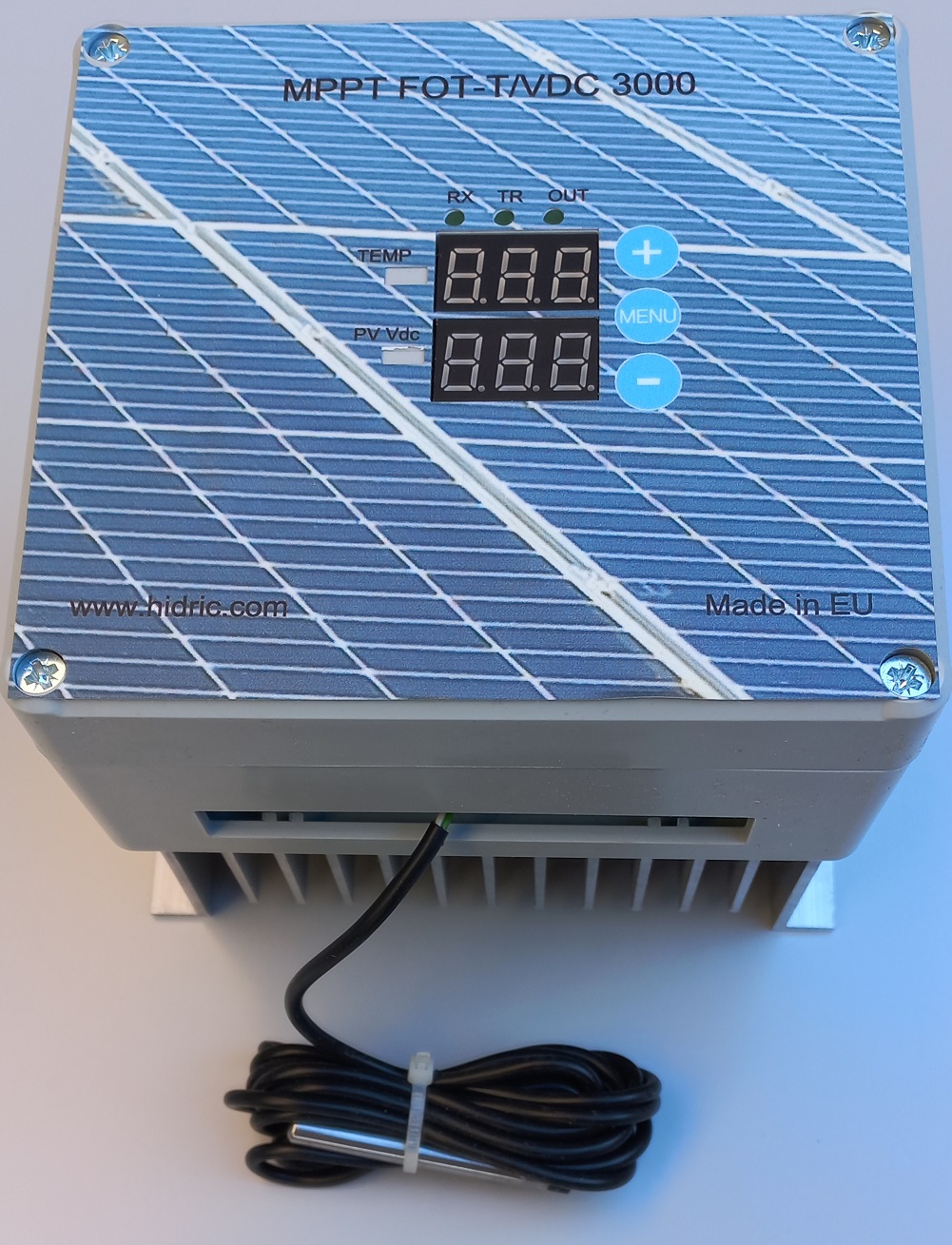
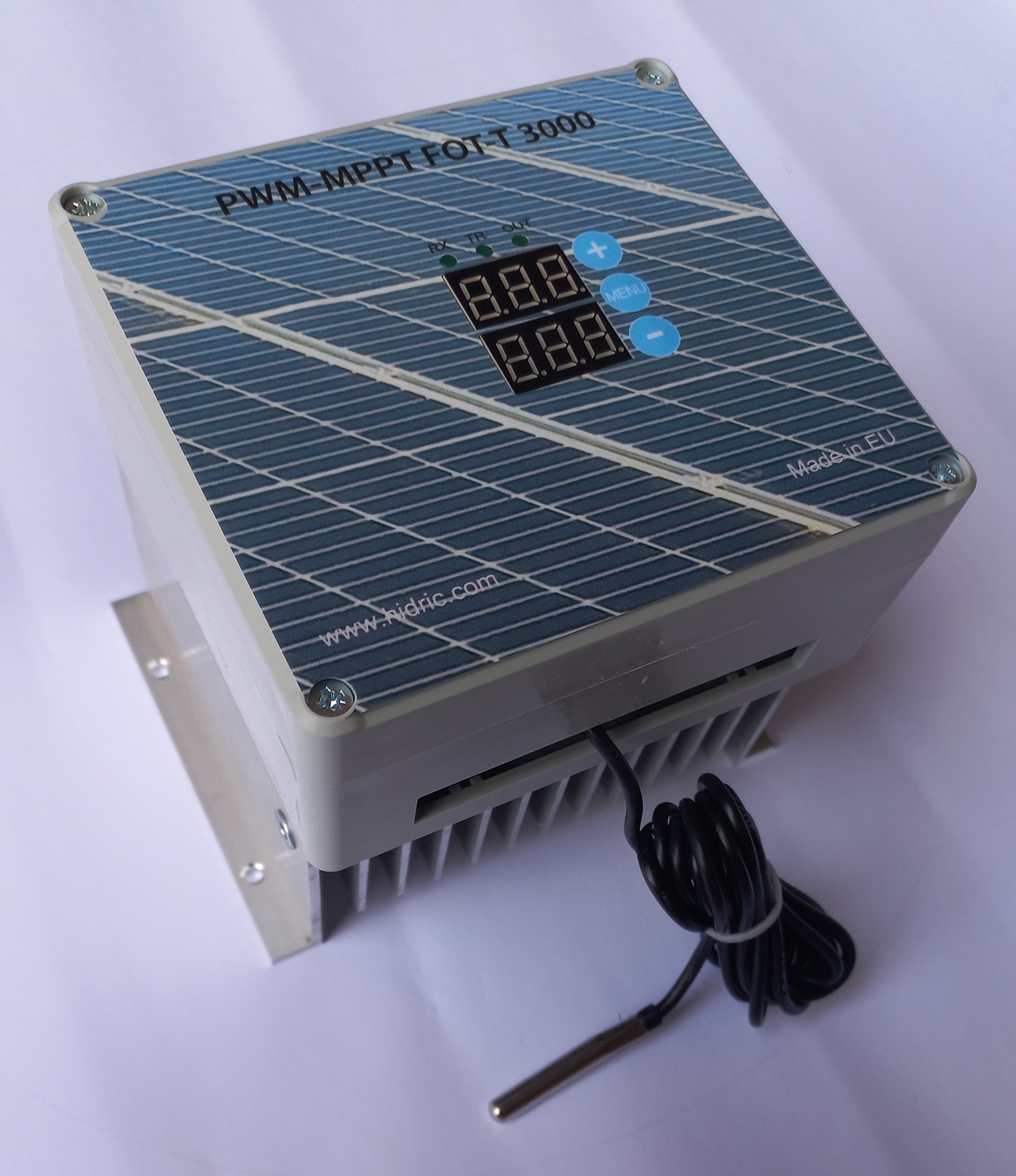
PHOTO THERMAL REGULATORS FOT-T 3000
Panel power up to 2900 W.
Nominal current up to 13.5 A
Built-in thermostat. Allows temperature adjustment of 10-99ºC
Temperature sensor with 2 m cable.
Relay output (potential free), which is activated when the set temperature is reached.
WORK OPTIMUM:
- 4-5 PV panels (465-550W) any brand. Q: 1860-2200Wp. U: 150-230Vdc. And: 12.9-13.5A
- 1 Resistance 230V-4000W (or 2000W+2000W connected in parallel)
The FOT-T 3000 regulator needs a minimum of 150V (4 PV panels) and accepts up to 350V (about 8 PV panels). The input current Ioc cannot exceed 13.75A. With voltage 150-250V you can use conventional resistance of 230Vac. With voltage >250-350V it is necessary to use three-phase resistors 400Vac
Transistors with high headroom (provide long, trouble-free operation)
Huge heatsink for passive cooling, eliminating the need for a fan.
Built-in load buffer
Built-in power supply, which works from panels, not from the mains.
Two screens: one shows the current temperature of the thermos, the other shows the current default power or the voltage of the panels and the maximum power.
RS485 communication to read operating parameters from a computer.
Built-in acoustic alarm Temperature control of the heat sink and inside the casing.
Dimensions 140x120x125mm
HOW TO CALCULATE THE PHOTOTHERMAL SYSTEM
To buy or install a photothermal system correctly, it is necessary to know three variables:
- Number of photovoltaic panels (N)
- Volume of hot water needed (Lt/day)
- Resistance power (P)
We start from the basis that the FOT-T 3000 Photothermal regulator is used. This regulator allows up to 2850Wp of PV panel.
1. Number of panels and working voltage. The FOT-T 3000 regulator needs a minimum of 150Vdc and a maximum of 300Vdc to be activated. Therefore, the minimum voltage of the PV panel must be 150Vdc. To obtain this voltage, the PV panels will be connected in series. Let’s suppose we have a 500W panel at 41V 13.5A. The minimum number of panels will be 150/41 = 3.6 units, rounding up is 4 panels. The voltage will be U = 41 · 4 = 164Vdc. The installed panel power would be 500W · 4 = 2000W. This value would be the minimum, but we see that it can be improved, since the FOT-T regulator allows more power. If we add one more panel, we get:
N = 5 => Working voltage = 5 · 41V = 205Vdc
Installed power = 5 · 500W = 2500Wp
2. Volume of hot water (Lt/day). For private residential use, the CTE establishes that consumption is 28 liters per person per day. To this value we must add the volume of thermal inertia when working in photovoltaics (Vit) plus a daily factor (I). You can consider the median number of people living in the house or overestimate the volume by considering the days when there are ‘guests’. Let’s take a calculation example. Usually 5 people live in the house, but on weekends 7 people come together.
The inertia value can be between 1.1-1.8. In the example we will use 1.5 The daily factor value can be from 1 to 3. In the example we will use 1.5.
It would be like having water for 1.5 days without the sun coming out.
Hot water volume during the week = 28 L/p-d · 5 · Vit · I = 28 · 5 · 1.5 · 1.5 = 315Lt
Hot water volume on weekends = 28 L/p-d · 7 · Vit · I = 28 · 5 · 1.5 · 1.5 = 441Lt
The accumulator that is on the market will be chosen, with the value closest to the result obtained. The volume of 315Lt or 441Lt will be chosen according to the available budget
3. Resistance power (P). Sometimes the accumulator already exists. In this case the limiting factor is the thread pitch of the electrical resistance. If it is a 1″ thread (dn25), you will be limited to the maximum resistance power that exists in this thread pitch. Normally, electric water heaters have a 1″ thread and accumulators have a thread pitch of 1-1/4″, 1-1/2″ or even 2″ in the larger ones. If the accumulator has an internal coil, it can also condition the length (L) of the resistance. You will have to verify this. Let’s say we have a 150L water heater with a 1″ thread. The FOT-T 3000 regulator allows you to use a conventional 230Vac resistance. This is a great advantage. To know exactly the real power absorbed by the resistance, we will work by comparing the nominal voltage (230V) with the one supplied. In our example (point 1), it is 205Vdc.
First we look for the nominal resistance from the FV power (applying Ohm) => R= 230^2/2500= 21.2Ohm. That is, we need to find a resistor that is as close to this value as possible. If we look at the resistors available in 1″ (link) we see that the 1500W model is the closest. From here, we can calculate how much power the resistor will actually absorb:
Pabs. = (205/230)^2 · 1500W = 1192W
WHICH RESISTOR TO USE WITH THE FOT-T 3000 REGULATOR
INSTALLED POWER |
RESISTANCE USED |
POWER ABSORBED BY THE RESISTANCE (W) |
EFFICIENCY REGARDING Wp (%) |
| x4 · 455W= 1820Wp – 164.5Vcc | 230 Vac- 1000 W | 510 W | 28 % |
| “ | 230 Vac-1500 W | 766 W | 42 % |
| “ | 230 Vac-2000 W | 1021 W | 56 % |
| “ | 230 Vac-3000 W | 1532 W | 84 % |
| “ | 230 Vac-4000 W | 1820 W | 100 % |
INSTALLED POWER |
RESISTANCE USED |
POWER ABSORBED BY THE RESISTANCE (W) |
EFFICIENCY REGARDING Wp (%) |
| x4 · 465W= 1860Wp – 166Vcc | 230 Vac- 1000 W | 520 W | 28 % |
| “ | 230 Vac-1500 W | 781 W | 42 % |
| “ | 230 Vac-2000 W | 1041 W | 56 % |
| “ | 230 Vac-3000 W | 1562 W | 84 % |
| “ | 230 Vac-4000 W | 1860 W | 100 % |
INSTALLED POWER |
RESISTANCE USED |
POWER ABSORBED BY THE RESISTANCE (W) |
EFFICIENCY REGARDING Wp (%) |
| x4 · 550W= 2200Wp – 167,6Vcc | 230 Vac- 1000 W | 531 W | 24 % |
| “ | 230 Vac-1500 W | 796 W | 36 % |
| “ | 230 Vac-2000 W | 1062 W | 48 % |
| “ | 230 Vac-3000 W | 1593 W | 72 % |
| “ | 230 Vac-4000 W | 2124 W | 96 % |
REGULATION CTE DB HE4
The FOT-T regulator complies perfectly with the CTE Basic Document HE4 regulations section 3 and 4:
3 Quantification of the demand
3.1 Minimum renewable contribution for ACS and/or pool air conditioning
1 The minimum contribution of energy from renewable sources will cover at least 70% of the annual energy demand for DHW and for pool air conditioning, obtained from the monthly values, and including thermal losses for distribution, accumulation and recirculation This minimum contribution can be reduced to 60% when the DHW demand is less than 5000 l/d. Only the renewable contribution of energy originating on site or in the vicinity of the building will be considered.
In addition, from Hidric ús we can offer the Justification, as described in the Base Document HE4-Annex F:
4 Justification of the demand
To justify that a building meets the requirements of this DB, the project documents shall include the following information about the building or part of the building evaluated:
a) the monthly demand for domestic hot water (DHW) and pool air conditioning, including thermal losses due to distribution, accumulation and recirculation.
b) the renewable contribution made to meet the energy needs for DHW and pool air conditioning.
c) the contribution of the residual energy provided, if applicable, for the ACS;
d) verification that the renewable contribution for ACS needs used covers the mandatory contribution.
DESCRIPTION FOR TECHNICAL SPECIFICATIONS
If you have to write a project or technical prescriptions that include Photothermia and you want to use our FOT-T 3000 system in Vcc system you can use the following description:
Photothermal regulator type FOT-T 3000 working with Vcc voltage in PWM – MPPT mode. PV panel maximum power of 2800-3000W, working voltage 150-250Vdc (max 350Vdc), working current 9-13A, (max 13.5A), capable of providing power to a conventional electric resistance of 1500-4000W of voltage nominal 230Vac. It incorporates a temperature probe with a standard 2m cable. On-screen display of the vessel temperature (accumulator), and plate power. Allows you to adjust the setpoint temperature in values of 1ºC between 10-99ºC. Relay output 8 without potential) which is activated when the set temperature is reached. Box with passive cooling (external finned resistance). 100% US design and manufacture. CE certificate.
HOW TO REDUCE THE ELECTRICAL CONSUMPTION OF A HEAT PUMP?
The heat pump is associated with one or two water accumulators. Normally a 30-60L accumulator for DHW and a second one for variable volume heating. The electricity consumption associated with heating water can be perfectly replaced by PHOTOTHERMY.
By placing an electrical resistance in the ACS accumulator of the heat pump, the saving of electrical energy for heating water will be 98-100%. This electrical resistance will be activated with Photothermia through the FOT-T 3000 regulator associated with photovoltaic panels.
In this way, you will have the heat pump, freed from the consumption of heating hot water.
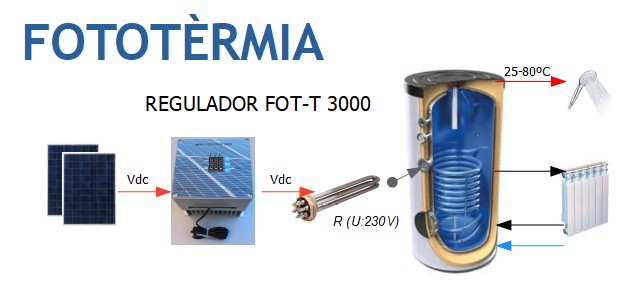
FAQS
* What is Photothermal for DHW production?
Heat water using photovoltaic panels (not to be confused with thermal solar panels), using a FOT-T regulator, an ACS hot water accumulator or electric thermo, associated with an electrical resistance of nominal voltage 230Vac
* Can a conventional electrical resistance be used?
Yes This is the great simplicity of the FOT-T regulator. You can use a 230Vac nominal voltage resistor or a 400Vac three-phase resistor. Each regulator will be associated with a 230Vac phase
*What power and resistance voltage must the electric heater or thermos have using the FOT-T 2000 or 3000 regulator?
The resistance of the electric heater does not need to match the power of the photovoltaic panels. You can use any resistance. But before buying it you need to do calculations to determine the power. Consult us to ensure. The power of the photovoltaic field is limited by the input power of the regulator (1900-2900W depending on the regulator). We recommend that the voltage of the photovoltaic field does not exceed the nominal voltage of the resistor (230V).
*What conventional electricity or gas (natural) energy savings can I get?
If you have mains electricity to heat water (electric heater). The average monthly consumption with a resistance of 2000W (8333W/month), is These values you will stop paying with photothermia.
If you have a mixed boiler (DHW + heating) and it is used for DHW 1.5h/day, with an average consumption of 0.19m3/h of gas, €24.73/month is spent.
This would be the amount you will stop paying the gas supplier, stopping importing 11.4m3 of gas per month (136.8m3 per year).
*If there is not enough insolation (rainy, cloudy days, etc.), does photothermia work?
The electrical resistance works from the first rays of the sun, but indeed the voltage will be low on cloudy days. You can use accumulators with two independent resistors. One controlled by photovoltaics (photothermal) and a second with conventional network support, and adjusted by means of a thermostat to a low temperature, but sufficient for comfort (for example at 23ºC).
On an annual scale (energy needed to heat the DHW for a year), Photothermia will produce much more than the minimum required by the CTE standard, although on a specific day it may need support from another energy source.
Our advice is that when buying the accumulator think with a sufficient reserve (2 or 3 days without sun). More hot water reserve, greater non-photovoltaic (or support) energy savings.
*What is the disadvantage of heating water directly with photovoltaic panels?
The solar panel works at maximum power only at optimum voltage. Connecting the thermocouple resistor directly to the PV panel causes too high a load and as a result a voltage drop. At reduced operating voltage, the panel produces even several times less current than at optimal voltage. Nothing happens to the panel, but it involves more work time.
To solve this fact, the FOT-T regulator incorporates the PWM-MPPT option into its work algorithm. It therefore allows at the time of start-up to activate the PWM operating mode and from there it searches for the point of maximum efficiency (MPPT mode). In this way, both in one case and in the other, an optimum of energy transferred from the plate to the resistor is guaranteed.
*Once the water is heated, can I use the excess energy?
Yes. The FOT-T regulators have a relay output (no potential), which is activated once the internal thermostat has reached the set temperature.
* Can Photothermia be used for vertically constructed buildings/apartments?
Yes. Complies creditably with CTE DB HE4 regulations. It can perfectly replace solar thermal panels. PV panels are placed on the roof and the wiring (Vcc) is lowered to each apartment. The FOT-T 3000 regulator is placed next to the electric heater. The electric heater will have a double resistance (2 230V resistances).
* Can Photothermia replace a heat pump?
The objective of Photothermia is to heat water with a conventional resistance, located inside a conventional accumulator. It can help the heat pump or a heating system to reduce energy expenditure. It can also help reduce energy expenditure when heating water for DHW or for heating or for industrial processes or heating swimming pools. What is certain is that photothermia with the FOT-T regulator and a suitable resistance, the heat pump or the conventional heating system will stop consuming a lot of external energy.
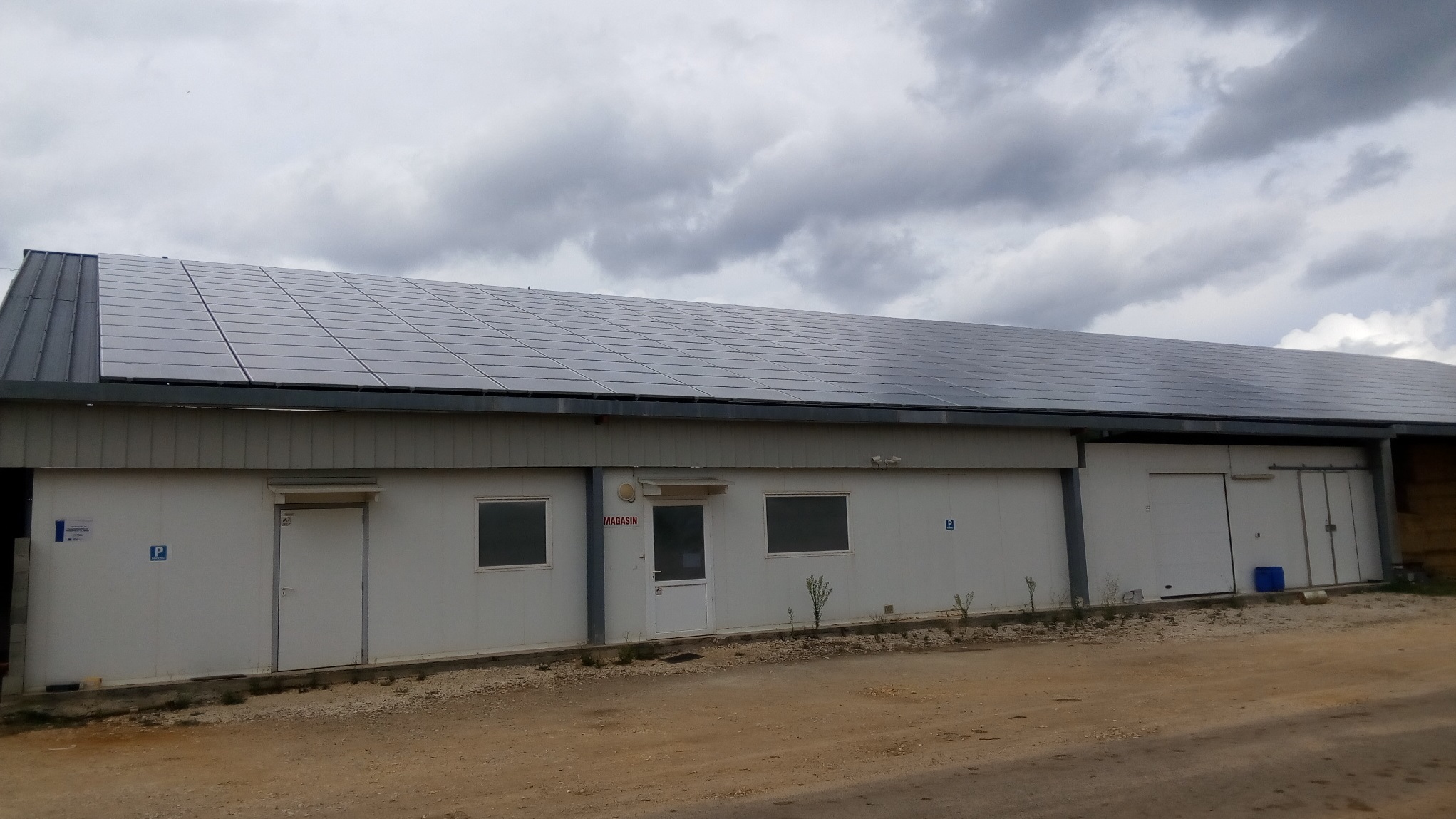
AGRICULTURAL – INDUSTRIAL PHOTOTHERMY – WATER DISINFECTION BY TEMPERATURE
-We can also offer solutions for industry and the agricultural sector.
Having hot water, depending on which processes it is essential (dry cleaners, public swimming pools, food industry, etc.).
Photothermia can also be used to disinfect water using temperature, in processes where you don’t want to apply chemicals or UV lights.
Ask for more information on how our products can help you reduce your carbon footprint.
NEWS AND PRACTICAL EXAMPLES
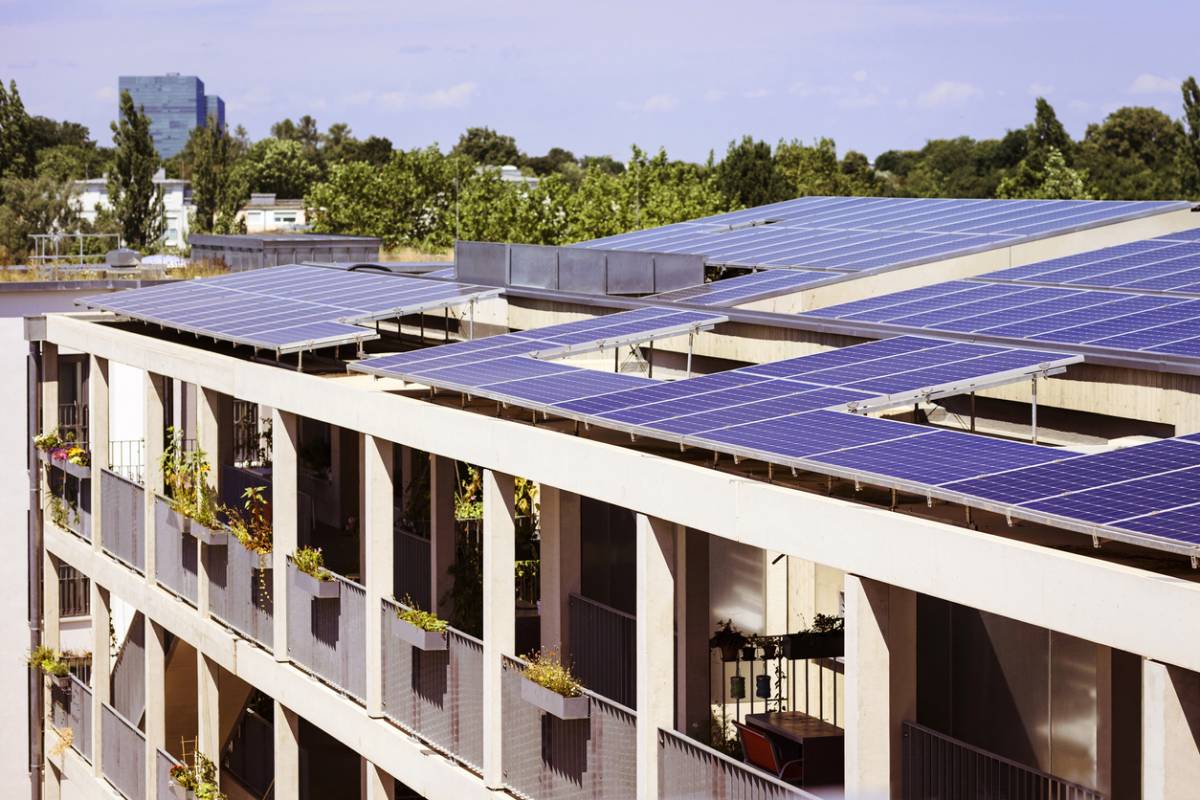
PHOTOVOLTAIC SOLAR ENERGY (PHOTOTERM) TO PROVIDE WATER AND HEATING TO A BUILDING OF 80 DWELLINGS
Thanks to a solar FOTOTHERMY installation carried out by one of our customers, the neighbors of a community of owners made up of 80 homes, take advantage of solar photovoltaic energy to obtain heating and domestic hot water (DHW). The building is for residential use, it is configured in the form of an open block of six floors. The homes have a size of between 68 and 115 m2. Although the photothermal installation prioritizes the energy contribution of the solar field to produce hot water and heating, it is also supported by two boilers that guarantee continuity of supply.
Configuration of the solar photothermal installation
The installation consists of a photovoltaic solar system made up of 108 460W panels at a ratio of 1.35 panels per neighbor installed on the roof. The community already had two gas-oil boilers installed and two 4500 Lt accumulators for DHW (at a rate of 28L/person-day of hot water). Each accumulator has two serpentine lines internally. One is the primary circuit connected to the heating (with glycol) and the second coil is a secondary that goes back to the boiler for the central heating.
With Photothermia, we proceeded to put electrical resistances in each 4500Lt accumulator. Circuits were made in series every 6 PV panels (2760W). Photovoltaic wiring was lowered from the roof to the boiler-accumulator room. Each line was protected with magnetothermal switch Vcc and transient overvoltage Vcc. Each PV line was connected to a FOT-T 3000 regulator and this to a conventional 230V-4000W resistor (each resistor was three-phase 12000W). Since the PV panels were installed in coplanar format with an inclination of 22º, an already expected loss of -18% was recorded. Therefore, each photovoltaic field provided 2263Wp at 195Vdc. The power absorbed by each resistor was 2875W. In total, a photothermal contribution of 51.7kWh was made.
Maintenance of photothermia
Once each FOT-T 3000 regulator is programmed to a set temperature of 82ºC, no maintenance is required. The cost of maintaining the property has gone exclusively to the maintenance of the boilers.
Save diesel with photothermia
The property (community of owners of 80 neighbors) had a daily diesel consumption of €538. With the installation of photothermia, daily consumption dropped to €38/day.

